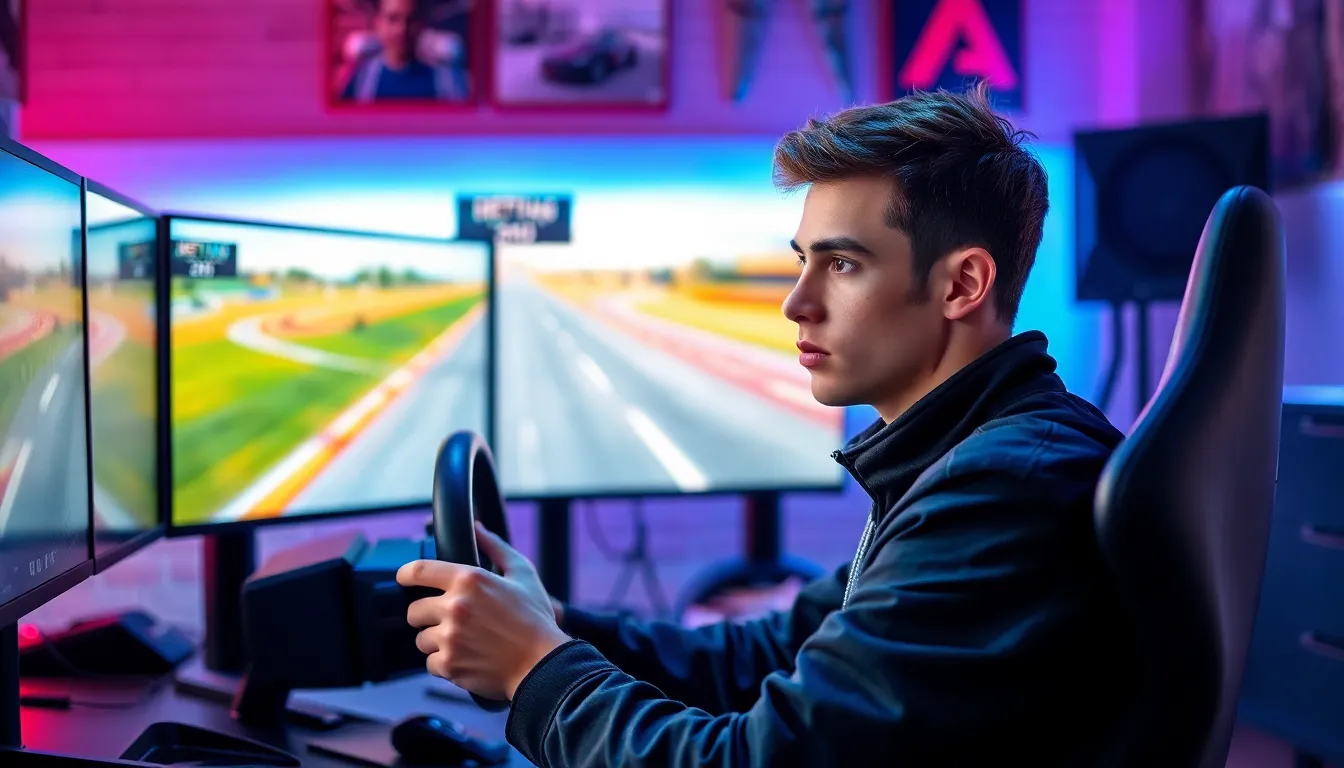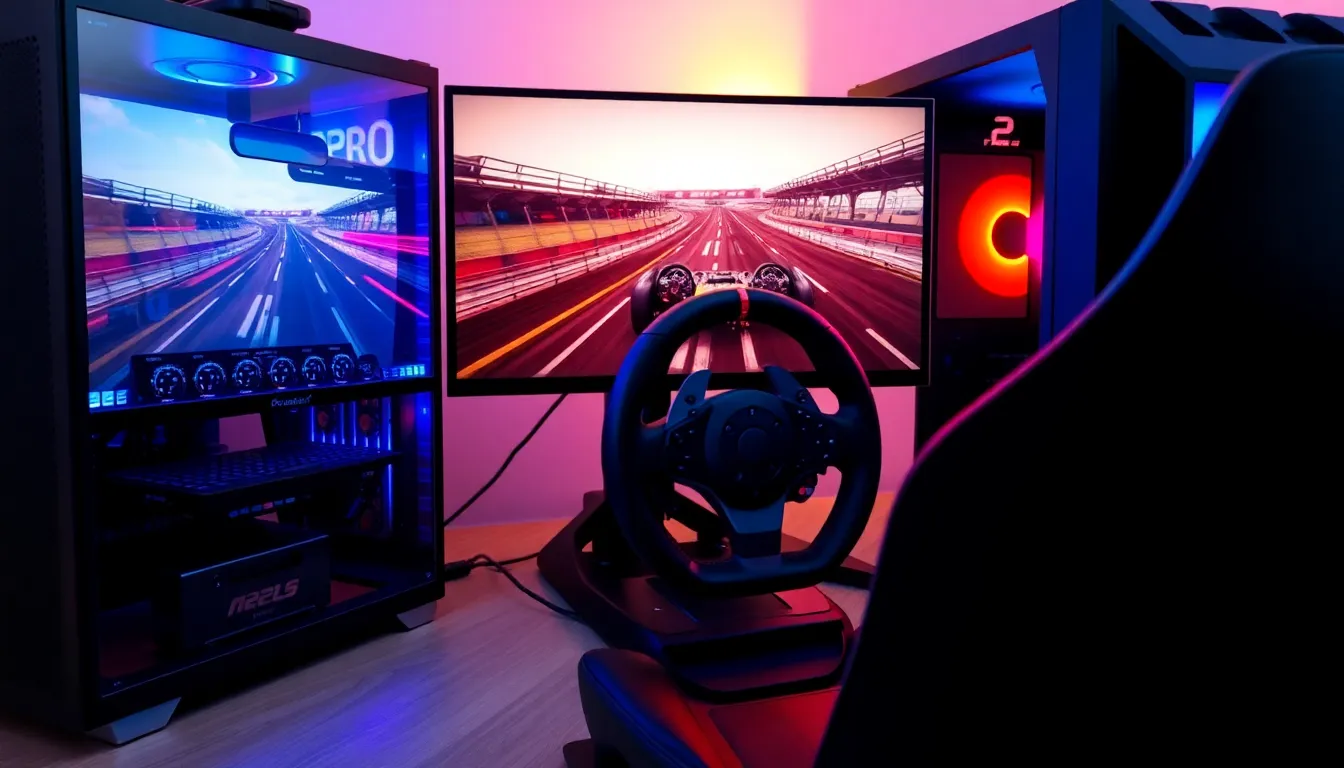
Sim Racing PC: Boost Your Gaming Experience with the Ultimate Setup
In the world of racing, the thrill of speed and competition is just a click away. A powerful sim racing PC can transform any living room into a high-octane racetrack. Forget about the days of squinting at pixelated graphics and lagging frames; today’s technology offers an immersive experience that makes you feel like you’re behind the wheel of a real race car.
Sim Racing PC
Sim racing PC refers to a computer specifically designed for sim racing applications. These PCs produce immersive graphics, realistic physics, and smooth frame rates, enhancing the overall racing experience. High-performance components play a crucial role in achieving the desired results.
Typically, a sim racing PC features a powerful CPU, such as Intel Core i7 or AMD Ryzen 7, which handles complex calculations efficiently. Graphics cards like NVIDIA GeForce RTX series or AMD Radeon RX series deliver stunning visuals at high resolutions. RAM is equally important; 16GB is a standard baseline, while 32GB provides additional performance for demanding simulations.
Storage solutions impact loading times and streaming performance. SSDs significantly reduce wait times, allowing users to jump straight into races without delays. Also, cooling solutions, such as aftermarket heat sinks and liquid cooling systems, ensure components perform optimally during extended gaming sessions.
Peripherals enhance the sim racing experience further. Racing wheels with force feedback create a realistic driving sensation. Pedal sets, often adjustable, contribute to an accurate representation of real-world driving dynamics. Together, these components form an ecosystem that elevates sim racing from a simple game to a true simulation experience.
Building or purchasing a pre-built sim racing PC involves evaluating intended usage. Some users prioritize ultra-settings for specific simulations, while others focus on versatility across multiple titles. Each choice ultimately affects performance and budget, meaning players must align their specifications with their racing goals.
Key Components of a Sim Racing PC

A high-performance sim racing PC relies on specific components for a competitive experience. Each part contributes to the overall effectiveness in simulating realistic driving scenarios.
CPU Considerations
Selecting a CPU is critical for sim racing. Intel Core i7 or AMD Ryzen 7 processors serve as excellent choices due to their multi-threading capabilities and high clock speeds. Performance can lag with lesser CPUs, particularly in demanding scenarios. Users aiming for ultra settings should consider even higher-end options, like the Intel Core i9 or AMD Ryzen 9. These processors maintain frame rates while executing complex physics and AI calculations. A reliable cooling system becomes essential with high-performance chips, ensuring sustained operation during extended races.
Graphics Card Recommendations
The GPU plays a pivotal role in rendering stunning visuals. NVIDIA GeForce RTX and AMD Radeon RX series are top contenders, providing exceptional graphics and support for ray tracing. Users must match the GPU with the desired resolution and settings for optimal performance. For 1440p gaming, GPUs like the RTX 3060 or RX 6700 XT suffice, while 4K racing demands options like the RTX 3080 or RX 6900 XT. Additionally, VR-capable GPUs heighten immersion for users employing virtual reality headsets.
Memory and Storage Requirements
Memory and storage choices significantly impact loading times and overall system speed. A minimum of 16GB of RAM is advisable for most simulations, while 32GB is ideal for those running multiple applications. Faster RAM configurations can improve performance, particularly in resource-intensive races. For storage, SSDs outperform traditional hard drives, reducing load times and enhancing gameplay. Users should prioritize NVMe SSDs for their speed, allowing quick access to necessary data during extensive racing sessions.
Essential Accessories for Sim Racing
Essential accessories enhance the experience of sim racing, providing the tools necessary for immersion and precision.
Racing Wheels and Pedals
Racing wheels and pedals serve as the foundation of a realistic simulation. High-quality options like the Logitech G923 or Thrustmaster T300 RS deliver responsive feedback and precision control. Those looking for realism might prefer force feedback wheels that simulate tire feel and road conditions. Pedal sets also vary in quality, with options like Fanatec Clubsport Pedals providing adjustable resistance and travel. Dedicated sim racers frequently opt for load-cell brake pedals for better modulation. For optimal performance, pairing a racing wheel with a pedal set that’s compatible ensures a cohesive driving experience.
Monitors and VR Headsets
Monitors and VR headsets transform the visual aspect of sim racing. A triple-monitor setup offers an expansive field of view, enhancing immersion, with screens like the ASUS ROG Swift or Acer Predator being popular choices. Additionally, many racers opt for ultra-wide monitors that provide a cinematic experience. On the other hand, virtual reality headsets such as the Oculus Rift S or HTC Vive Pro deliver unparalleled immersion. Those using VR experience a depth of perception that traditional displays lack. Both options enhance the connection between the driver and the virtual environment, improving overall gameplay enjoyment significantly.
Optimizing Your Sim Racing PC
Optimizing a sim racing PC enhances the overall experience by improving performance and responsiveness. Users can achieve maximum immersion through careful adjustments to software and game settings as well as performance tweaks.
Software and Game Settings
Adjusting software and game settings is crucial for optimal performance. Lowering graphical settings such as shadows and reflections can significantly increase frame rates. Configurations like enabling V-Sync minimize screen tearing, which provides a smoother visual experience. Additionally, custom settings for field of view can improve spatial awareness in racing simulations. Utilizing tools like NVIDIA Control Panel or AMD Radeon Settings allows users to prioritize performance over visual fidelity, ensuring smoother gameplay.
Performance Tweaks
Implementing performance tweaks further enhances a sim racing PC’s capabilities. Overclocking the GPU and CPU can lead to better performance but requires careful monitoring of temperatures. Regularly updating drivers ensures compatibility with the latest games and patches, which can improve stability. Users should close background applications to free up resources, as this can reduce lag and improve responsiveness. Ensuring adequate cooling solutions, like high-quality fans or liquid cooling systems, maintains optimal performance, particularly during intense gaming sessions.
Conclusion
A dedicated sim racing PC transforms the gaming experience into something truly immersive. With the right components and accessories, racers can enjoy stunning graphics and responsive controls that mimic real-life driving. The combination of powerful CPUs and GPUs ensures that every detail is rendered beautifully while maintaining smooth frame rates.
Investing in high-quality peripherals like racing wheels and pedals further enhances realism, making each race feel authentic. Optimizing software settings and ensuring proper cooling can significantly improve performance, allowing for longer and more enjoyable gaming sessions.
For those passionate about sim racing, building or purchasing a tailored PC is a worthwhile endeavor that elevates the thrill of virtual racing to new heights.
